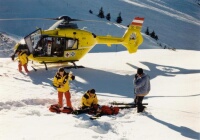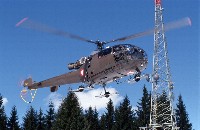Noteably the European nation with the smallest funds allocated to defence, the air arm of Austria gets an even smaller share of the 0,79% GNP this year, with around half a billion ATS for the running operations earmarked.
It is not too dramatic to point out that with an average age of over 20 years within the fleets assets, a whole new Air Force would be needed in fact - maybe exept the AB-212s and the PC-7s.
But the first ones will be modernized and the later ones are in danger of becoming useless.

Forced by catastrophic Avalanches, the Austrian politics funds Sikorsky S-70 Blackhawk.
Foto: Martin Rosenkranz
|
Forced to act by the power of nature in the face of the Galtuer Avalanches of 1999, the Austrian politics quite quickly opened funds for new helicopters and the type-selection for 9 medium transport-types was announced by Oct. 6th in favour of the Sikorsky S-70 Blackhawk.
Friday Dec. 29th saw the final contract's signation in the Austrian MoD. As Sikorsky's first offer for the aircrafts - specialized after the Austrian demands in the S-70A-42 sub-variant - was for 3 bill. ATS (218 mill. EUR), the treaty was signed now for 2,7 bill. ATS (196 mill. EUR).
Because of Austrian import-taxes, Sikorsky will only see 2,2 bill. ATS (159 mill. EUR) from that deal, but more important is that the US manufacturer and its partners out of United Technologies Group have done commitments for offset-cooperations with Austrian industrial-partners in the volume of 5,8 bill. ATS (421,5 mill. EUR), therefore far overfilling the asked compensation-quote.
Some uncertainties in that subject are remaining anyway as the Sikorsky-suggested FMS sale of the EW-kit for the S-70s is still not approved by the US-DoD, but should be at Stratford for integration until July.
Only four aircrafts will have the ESSS kit for the moment.
Despite - without the Galtuer catastrophy - the Air-Staff would have preferred to wait for something in the NH-90 class, the overwhelming of any operational matters by this offset-gainings draws a domination on the much larger upcoming project.

The "historic window" for a Draken-successor is broadly open only for this year.
Foto: Georg Mader
|
The Austrian centre-right cabinet seems to further fulfill its security-programmes from out of its governmental-declaration.
It includes the passus of "
...most cost-effective re-acquisition of air-surveillance planes after the Draken.
The ministers for defence and finances will togehter develop the pre-conditions to allow a purchase within this legislative-periode.
The project will be handled under the possibilities of the overall budgetary-situation, but without further burdens for the defence-budget."
The - defence-related - sceptical or at least non-interested Austrian public seems slowly to be prepared for the inevitable nationwide debate about the Draken-successor in the upcoming months.
Here a confrontation within media and politics in a totally different scale than around the 9 helicopters is to expect.
Defence-minister Scheibner's public arguing strategy will most likley be based around the "zero-cost" budgetary factor connected with the side-offsets.
A renewed "Request for Information" was sent out to the manufacturers of the JAS-39 Gripen, the F-16C/D, F/A-18E/F (both FMS) and the Mirage 2000-5II.
Altough Russian Defence Industry officials up to RAC-MiG director Nikitin and even president Putin made strong efforts in Austria to be included with the MiG-29SMT, the earlier Air-Staffs guarantees that every bidder will be handled equal were overruled by unclear political aspects and the Austro-MiG was rejected to even take part.
Internal sources are estimating a head to head competition between the Gripen and the F-16, with constant slight pushes reported for the Swedish project, even by president Klestil when visiting Sweden.
A basic decision to start the RFP-stage should fall during spring 2001 and a package for between 15 and 22 bill. ATS will be selected until the end of the year.
Nevertheless now it is almost too late to prevent a break in air-surveillance over Austria from 2003 on.
Nevertheless the "historic window" for a Draken-successor is broadly seen open only for this year as national elections are following in 2003.

OEAMTC has ordered 11 EC-135s for civil-rescue flying-service and is now publicly looking for pilots.
Foto: OEAMTC
|
A new challenge for the operability of all the future flying assets of the Fliegerdivision appeared suddenly and in an unexpected scale last year.
As the new center-right cabinet has forced a strict savings-direction in all the public services branches, it also has out-sourced the civil-rescue flying-service from the Ministry of Interior and a takeover of the police' helicopter-structure by the Austrian Automobile Association (OEAMTC) by July 2001 is prepared.
The OEAMTC has recently ordered 11 EC-135s to its existing fleet of the same type and is now publicly looking for pilots.
As these candidates have to confirm 2000 flying-hours, alpine- and external-load experience and night-flying capability, it is obvious that only a very limited number of such potential exists in Austria.
It was reported, that out of almost 50 pilots answering the demand, between 15 and 20 fully-qualified pilots out of the Army's Sqdns. - undermotivated due to constant missing political back-up in material renewal - were under them.
As they are the best educated in Austria, the OEAMTC underlines that these all are more than welcomed and that they will not need multi-engine ratings to join in.
If that development becomes reality in that scale, a final deadly blow to operability and readiness of the - constantly underfunded and strechted - capabilities of the Austrian AF's rotory-assets is secured.
It would push personnel-numbers back to where they have been 15 years ago and also lays a dramatic shadow on the readiness of the new helicopter.
Because at the moment, some 6-7 new rotory-pilots are trained per year, it would need around 6 years to get back the lost potential.

A rebuild Alouette III from Sitzerland and a merged AB-212 joined the fleet as crash-replacements.
Foto: Martin Rosenkranz

Crew-rotation circle is halted from the top-type down and no more candidates are trained on the Austrian jets.
Foto: Martin Rosenkranz
|
The blow somehow also will contradict recent assignments Defence-Minister Scheibner did to the planned EU crisis-reaction force, to which 4 Austrian helicopters are announced.
An aditional uncertainty for crews is that the helicopter bases at Schwaz in Tyrol and Annabichl in Carinthia are candidates to be axed.
More than a morale factor in contradiction, could be the starting modernisation of the AB-212s avionics and cockpit-layouts which targets the most possible similarity with the Collins-equipped S-70s.
One AB-212 was recently re-added to the fleet as 5D-HZ, merged from a crashed Austrian one and an ex-Sudanese airframe.
A complete rebuild Alouette III from Sitzerland was introduced as a crash-replacement last year.
Situation in the fixed-wing sector is not much better.
Austria operates the J-35OE as the last one worldwide since August 16th 2000 and without two-seaters, no OCU is possible. The remaining 19 pilots left at Zeltweg and Graz are waiting for the mentioned long overdue replacement step.
Quick relief came from buying hours on the JA-37 in Lulea/Sweden, but the booming airline-industry is constantly demanding highly-qualified pilots and Austrian Airlines and Lauda-Air are accepting a higher maximum entry-age, if jet-pilots are coming from the Bundesheer.
Today only a few of the 19 still have to fulfill long-year contracts for a training pay-back with the military, the rest could leave anytime.
The same situation is to be moaned within the pilots (5 of them part-time militia-pilots) on the 29 obsolete Saab 105OE jet-trainers from 3rd Sqn. at Linz-Hoersching.
Altough unsuitable, the two-seater is still part-time used for surveillance-duties, in the JaBo-role with 3cm gunpods and for jet-conversion training.
8 of them are on long-term lease to the Draken units.
Because of unexpected and unbudgeted fuel-price rising, app. 3 mill. Ltrs. of kerosene are missing in this years ops.-planning, one idea considered currently is to reduce the number of Saab 105OE gradually down to 16.
As the crew-rotation circle is halted from the top-type down, no candidates are also trained at the Flying-School at Zeltweg, therefore some PC-7 Trainers are partly unused and the others only moved by instructors.
Their times could even be over if a plan of the EURAC (European Air Chiefs Conference) Air Force Cdr. for a Joint Training Command for all the participating nations would be realized.

A leased CASA-235-300 is the most capable transport aircraft, a purchase is not to foresee.
Foto: Bundesheer
|
The same situation occurs in the small non-jet fixed-wing unit, where the general flying-crew situation is at its lowest.
The 4th Sqdn. at Langenlebarn operates 12 PC-6, two SC-7 Skyvans and the leased CASA-235-300, the later for 100 mill. ATS (4,5 mill. pounds) per year.
Part of the agreement with CASA was the chance to gain multi-engine ratings for future transport pilots, but as a true purchase of such a plane - beside highly in need - is the last one to foresee, again pilots left that unit and it consists of only 5 pilots today, of which 3 are not yet fully qualified.
Here the problem was that the CASA is flown commuter-like between Langenlebarn and Austrian contingents in Kosovo, which showed too much similarities to civil-services for some military-pilots.
An Austrian input into the EURAC Transport-Pool by two 9-ton transports in exchange for larger demands - similiarities to the two Swiss CN-295s are especially mentioned by the Austrian Air Staff - is the next targeted project.
So far no countermeasures are known to another recent problem, as the fixed air-surveillance radars on Austrias mountains (Goldhaube) will interfere commercial cellular-operators in neighboring Czech Republic and Germany in their upper wavelenghts from next year on.




